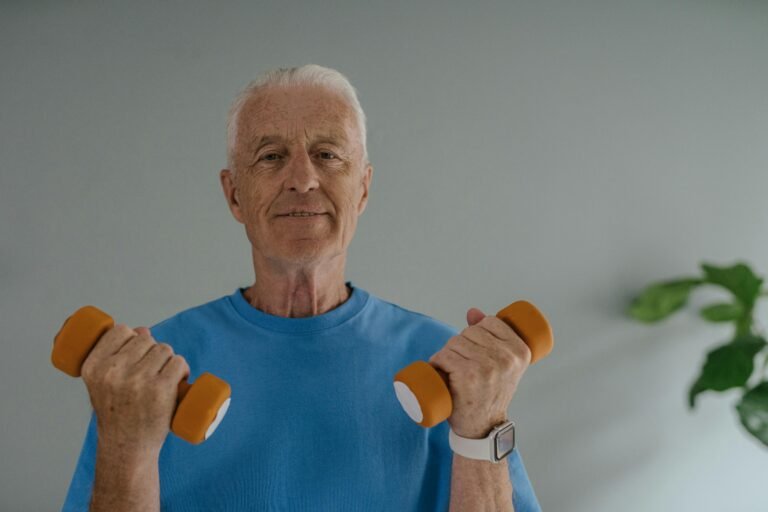Our muscles are more than just tools for movement. They’re a key player in determining how long and how well we live. As we age, preserving muscle mass and strength becomes crucial for longevity, mobility, and reducing the risk of chronic diseases.
Why muscle matters for longevity
Muscle mass isn’t just about looking strong; it’s directly tied to our healthspan. Studies have shown that low muscle mass is associated with higher mortality rates, even in people who are otherwise healthy. Sarcopenia, the natural loss of muscle mass with age, can begin as early as your 30s, accelerating after 50. By the time we hit our 70s, muscle loss can be as low as 30% if we don’t actively counter it.
Loss of muscle doesn’t just make us weaker. It’s linked to insulin resistance, metabolic decline, increased inflammation, and even reduced immune function. Essentially, healthy muscles contribute to keeping our entire body in balance.
Muscle mass and longevity: The science behind it
Various researchers highlight the importance of muscle strength as a predictor of mortality. People with higher muscle strength tend to live longer than those with weaker muscles, regardless of body fat levels. In fact, grip strength has been identified as one of the simplest ways to assess longevity potential.
A 2022 study in JAMA Network Open found that meeting both strength and aerobic exercise guidelines was linked to a significantly lower risk of all-cause mortality among individuals aged 65 to 85 years and older, compared to meeting neither set of guidelines. Thus, maintaining strength isn’t just about avoiding frailty—it’s about extending life itself.
Tips for maintaining muscle as you age
The good news? Muscle loss isn’t inevitable. Here’s how you can keep your muscle mass and strength as you age:
1. Prioritize resistance training
Lifting weights or doing bodyweight exercises like squats, lunges, and push-ups is one of the most effective ways to maintain and build muscle. Aim for 2-3 strength training sessions per week targeting all major muscle groups.

2. Get enough protein
Protein is the building block of muscle. As we age, our protein needs increase due to reduced efficiency in muscle protein synthesis. Experts recommend not less than 0.8 grams, but mainly around 1.2 grams of protein per kilogram of body weight daily for older adults.
We must not forget to include high-quality protein sources like:
- Eggs
- Lean meats
- Fish
- Dairy
- Plant-based options like tofu, lentils, and quinoa
3. Stay active throughout the day
Beyond structured workouts, stay active with walking, gardening, or other hobbies. Movement keeps your muscles engaged and helps prevent sedentary-related muscle loss.
4. Focus on nutrient-dense foods
In addition to protein, nutrients like vitamin D, magnesium, and omega-3 fatty acids are essential for muscle health. Fatty fish, leafy greens, nuts, and seeds can help meet these needs.
5. Manage stress and sleep
Chronic stress and poor sleep can increase cortisol levels, which can contribute to muscle breakdown. Prioritize 7-9 hours of quality sleep and incorporate stress-reduction techniques like meditation or deep breathing.
Groundbreaking innovations in muscle longevity
Recent scientific findings have introduced innovative ways to combat muscle loss. For example:
- Myostatin inhibitors: These experimental therapies block myostatin, a protein that limits muscle growth. Early studies suggest they may help reverse muscle loss in aging.
- NMN and NAD+ supplementation: These compounds, linked to cellular energy production, may improve muscle function and reduce age-related decline.
- Electrical muscle stimulation (EMS): While traditionally used for rehabilitation, EMS is gaining traction as a tool for maintaining muscle mass in older adults or those with limited mobility.

Why building muscle is a long-term investment in health
Think of muscle as your body’s health reserve. The more muscle you build and maintain now, the better equipped you’ll be to handle the challenges of aging. From improving balance and preventing falls to boosting metabolism and reducing inflammation, muscle plays a central role in keeping us thriving as we grow older.
By staying proactive with strength training, nutrition, and overall movement, we can make muscle maintenance a lifelong habit. And in doing so, we’re investing not only in years added to our life but in life added to our years.
Interested in more longevity-focused content? Check out Manuia Health blog for more.







